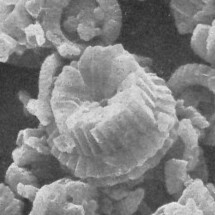Bomolithus elegans
Set number: 2325
-
1
-
2
-
3
-
4
-
5
-
6
-
7
-
8
-
9
-
10
-
11
-
12
-
13
-
14
-
15
-
16
-
17
-
18
-
19
-
20
-
21
-
22
-
23
10µm
Bomolithus elegans Roth, 1973
Emended by Bowman & Varol, 2021: Medium size (5.5–8.0μm) circular species of Bomolithus consisting of two discs and a column. The discs are equal (or approximately equal) in diameter and appear relatively flat to very slightly convex (clearly seen in the side-view). The segments of the median disc are “wedge-shaped” in the side-view. The high column is wide and parallel-sided or cylindrical and possesses a cone-like distal depression and a narrow canal that is closed with a central plug. The discs and column contain a similar number of segments (about 24–32), and the width of the disc segments is much broader than the width of the column segments.
In plan view, the discs appear a shade of white, the column appears shades of yellow, and the plug is smooth with unresolvable segments. In the distal view, the extinction lines are dextrogyre, whereas the extinction lines are laevogyre in the proximal view. When viewed using a gypsum plate, the horizontal axis of the coccolith lies within the blue sector on the distal/column-side. Still, the vertical axis of the coccolith lies within the blue sector on the proximal/disc side. The discs and column are birefringent in plan view and side view.
The wedge-shaped character of the median disk (as seen in the side-view) is most apparent in this species of Bomolithus. The relatively high column of Bomolithus is the diagnostic criterion for separating it from Heliotrochus. Bomolithus elegans possesses discs of equal or almost equal diameter, whereas the discs of Bomolithus cantabriae are of unequal diameter (the median disc is much narrower). The column of Bomolithus elegans is high and cylindrical, but the column of Bomolithus dydimolofous appears relatively low and dome-shaped. In the side-view, the median disc of Bomolithus elegans appears wedge-like, whereas Bomolithus dydimolofous possesses a lath-like median disc. In plan-view, the number of segments characterising Bomolithus elegans (about 24–32) is less than the number of segments representing Bomolithus dydimolofous (about 32–40). The disc and column segments are unequal in Bomolithus elegans (disc segments are much broader than column segments). In contrast, the disc and column segments are of approximately equal width in Bomolithus dydimolofous.
Bowman, A. R. & Varol, O. 2021. A Taxonomic Revision of Heliolithaceae - Applications in Resolving the Problematic Calcareous Nannofossil Biostratigraphy of the Paleocene. In: M. Montenary, M. (Ed.). Calcareous nannofossil biostratigraphy of the Stratigraphy and timescales. 6: 43-223.
Roth, P. H. 1973. Calcareous nannofossils: Leg 17 of the Deep Sea Drilling Project. Initial Reports of the Deep Sea Drilling Project. 17: 695-795.
